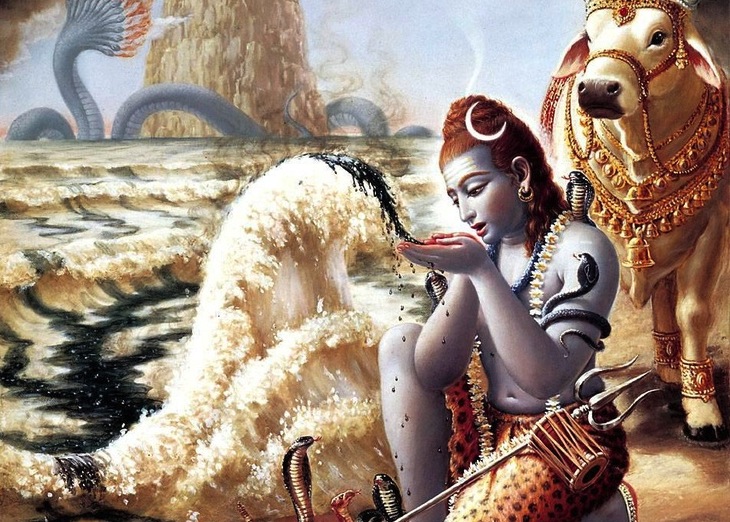
by Somya Devi | Feb 22, 2017 | Astrology, Conjunctions, Eclipses, Events, Holy Days
Healing Eclipse on the New Moon + Maha Shivaratri
Sunday begins the New Moon cycle and brings with it a powerful eclipse whose alignment offers some deep healing opportunities. The annular solar eclipse will be visible from much of Africa, South America, and Antarctica, and will coincide with the exact time of the darkest Moon phase at 6:58 a.m PST (14:58 UTC) on Sunday, February 26th. This eclipse occurs with the Sun, Moon, Mercury, and Ketu all in sidereal Aquarius within the Vedic nakshatra of Shatabisha.
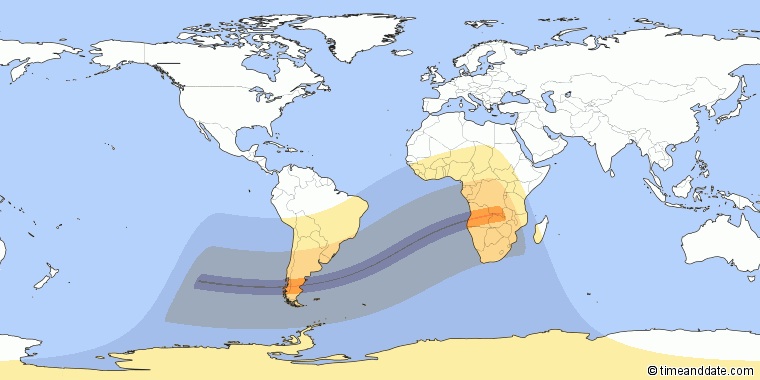
Aquarius
Aquarius is a sign ruled by Saturn, and it is where we remember something greater than ourselves. It is where we become inspired towards universal service, and to offering effort into society and for the greater good. Saturn, the planet of pressure and time, is aspecting the planets of this eclipse from his recent seat in sidereal Sagittarius, compelling us even more deeply to stand up for our principles and beliefs, and commit ourselves to these through hard work.
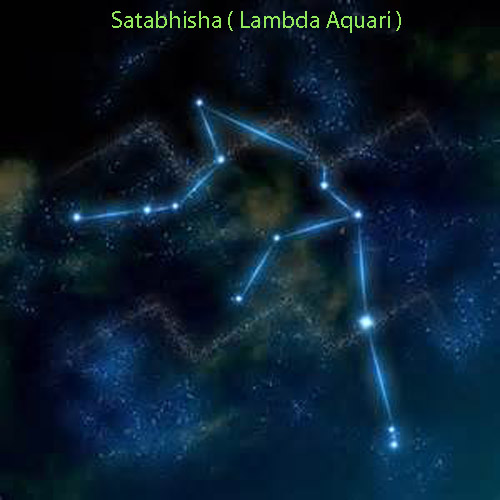
Shatabisha
Shatabisha is the Vedic nakshatra that most elicits the concept of healing. It is the star of the “100 physicians” or the “100 medicines,” and is ruled by Varuna, the deity of the cosmic waters. With many planets under the influence of this star, we are strongly called towards our journey of self-healing, trying many different medicines and healing techniques to get there. Having Ketu here, eclipsing the Sun and the Moon, presents the opportunity to go deeply into our subconscious blockages and find release from past karma and trauma.
The Greater Eclipse Cycle
This is the third solar eclipse that has occurred since Rahu and Ketu transited into the Leo-Aquarius axis in January of 2016 (download the Free E-Book and Forecast by Sign for this transit if you haven’t yet!). Throughout this time, we have experienced shadows and blockages coming up around the themes of the Leo-Aquarius axis. On a broad scale, this relates to the balance of personal power and universal service that we play out through society. On an individual level, it has raised questions around the house-themes of Leo and Aquarius in the personal Vedic birth chart.
We have been uncovering layers of our own karma through this time, and discovering where change is needed in our lives–either through a change in our actions or a change in our thoughts. Our personal challenges become most apparent during the eclipse windows, which have occurred this month, as well as during August and March of 2016. Though these windows can be difficult times, the power of the lunar nodes helps us to see where we are stuck. With self-awareness and observation it becomes less difficult, but when we are not paying attention or are clinging to our own attachments, the eclipses can feel like they are wreaking havoc on our lives.
Since this is the third and final pair of eclipses during this transit of Rahu and Ketu, it is a time for really reaching some clarity around the lessons being brought up over the last year-and-a-half. Eclipses do cause confusion and are inauspicious in general, but as we do the work of self-inquiry and practice astute awareness, we can gain insight and more light after going into the darkness of their shadows. The healing power behind Shatabisha nakshatra may present us with some different medicines, or practices, to assist in our evolutionary process, assisting us in learning how to flow better with the cosmic waters.
Shivaratri
In addition to the healing energy of this nakshatra, we are receiving the powerful gift of deep meditation offered by the Shivaratri holiday. Maha Shivaratri (or Sivaratri) is “the great night of Lord Shiva,” celebrated in India and around the world each year on the 14th night of the waning Moon this month. This year it falls on the night of Friday, February 24th into Saturday the 25th, around the world (except for mid-Australia/Japan and Eastward, where it falls on the 25th/26th).
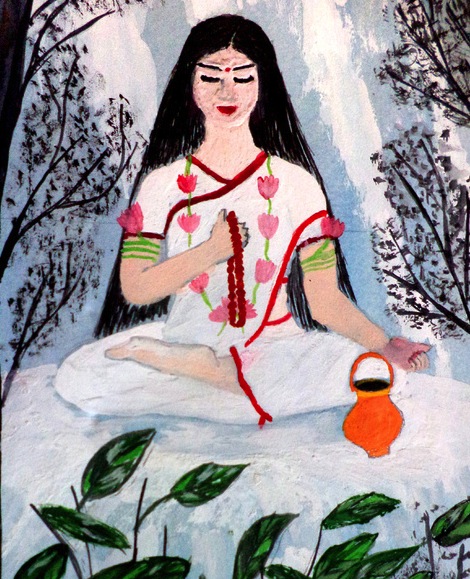 On Shivaratri, it is a common practice to stay up the whole night in meditation, fasting and praying. This commemorates the sacrifice made by Lord Shiva when he kept the poison that arose from the milk ocean in his throat in order to protect the entire creation. In this story, his wife Parvati held his throat to keep him from consuming the poison, and thus this holiday also commemorates the union of masculine and feminine forces, Shakti and Shiva, yin and yang. In many places this is represented by a celebration of Shiva and Parvati’s wedding, and one may see large statues of the two paraded about town and worshiped.
On Shivaratri, it is a common practice to stay up the whole night in meditation, fasting and praying. This commemorates the sacrifice made by Lord Shiva when he kept the poison that arose from the milk ocean in his throat in order to protect the entire creation. In this story, his wife Parvati held his throat to keep him from consuming the poison, and thus this holiday also commemorates the union of masculine and feminine forces, Shakti and Shiva, yin and yang. In many places this is represented by a celebration of Shiva and Parvati’s wedding, and one may see large statues of the two paraded about town and worshiped.
Shiva and Parvati represent the path towards awakening consciousness through the ascetic side of yoga, and the practices of tapas and renunciation. By renouncing food and sleep for one night, particularly on the night of Shivaratri, we can gain some of the benefit of the austerities that these two performed for aeons. Tapas, or austerities, are yogic practices of undergoing difficult situations in order to gain more patience, as well as deeper understanding that we are in fact the eternal soul and not the body-mind with which we normally identify.
On this Shivaratri, as we approach the transformative energy of the eclipse in Shatabisha, the opportunity for overcoming the challenges and shadows of our minds is great. The power of group meditation occurring all over the world also contributes to this. With the energy of Aquarius behind us, let us offer the fruits of our practice towards the peace and happiness of all beings on earth, and spread the benefit for the greater good.
Mantras for Maha Shivaratri:
Om Namah Shivaya (the panchakshari mantra – “I bow down to infinite consciousness”)
Tyagenaike Amrtatvamanashuhu (by renunciation alone, immortality is gained)
Personal chart readings are available to delve deeper into the meaning of this eclipse cycle in your life.
Did you like Healing Eclipse on the New Moon, following Maha Shivaratri? Please Like, Comment, and Share!
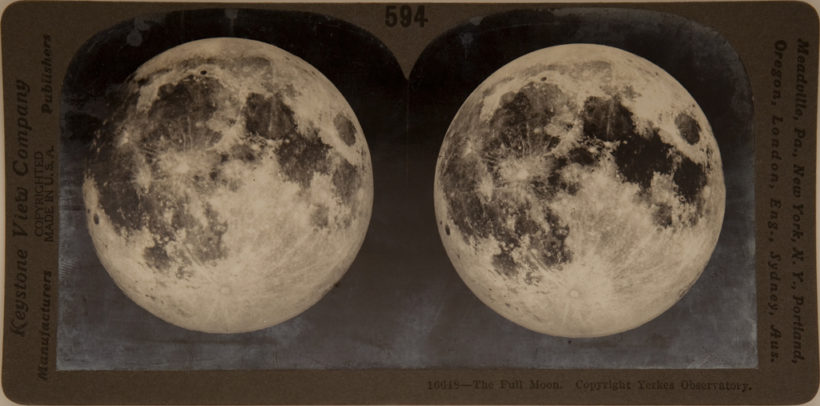
by Somya Devi | Jan 11, 2017 | Astrology, Conjunctions, Eclipses, Holy Days, Planets Changing Signs, Retrograde
Gemini Full Moon Offers a Fresh Start
The full Moon occurs in sidereal Gemini tonight! The exact full Moon time is 6:34 am EST on January 12th. This full Moon falls in the Vedic nakshatra of Punarvasu, a constellation of renewal. Meaning “good again,” or “more light,” this is a great nakshatra to connect with as we begin the new year. This star-sign comes after the stormy and turbulent nakshatra of Ardra, and represents the calm after the storm. Many people experienced 2016 as especially turbulent (and many astrological alignments contributed to that!). Now is is an excellent time to be reminded of the rebirth that can come after chaotic times.
Punarvasu can be identified in sidereal Gemini, around the stars Castor and Pollux. The preceding constellation, Ardra, is ruled by Rudra, a fierce form of Shiva. He reminds us of the destructive powers of nature, and challenges us to find peace and consciousness amidst turmoil. Punarvasu comes after Ardra, and signifies the return of light. During this time of year we begin to feel the light of the Sun returning after the December solstice, as the seasons begin to wax in the northern hemisphere. The deity for this nakshatra is Aditi, a fertile mother-goddess. After the rains, the ground becomes moist, lush and ready for new life to begin its journey upward.
What have the intense rains of winter watered in your life? What has been destroyed by them, creating space for something new to be planted? Where have you nourished the grounds thus far, and what do you desire to grow this year? Now is a time to rise up and connect with your intentions, offering your vision forward and finding the light after the wreckage. The Gemini full Moon offers a fresh start. This is fitting as it coincides with the start of the New Year, and also with Makara Sankranti (January 14th), a Hindu holiday celebrating the return of the light when the Sun enters sidereal Capricorn.
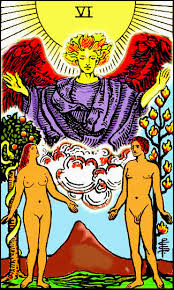 Both Gemini and Punarvasu are strongly dual in nature, enabling us to see both sides of a situation. In Western lore, the twins, Castor and Pollux are found here. In Vedic mythology, Gemini is called Mithuna, “the pair.” The two figures were seen in Vedic times as a male and a female, representing the yin and yang aspects of existence, and the dance between the two.
Both Gemini and Punarvasu are strongly dual in nature, enabling us to see both sides of a situation. In Western lore, the twins, Castor and Pollux are found here. In Vedic mythology, Gemini is called Mithuna, “the pair.” The two figures were seen in Vedic times as a male and a female, representing the yin and yang aspects of existence, and the dance between the two.
Gemini reminds us to be open, curious, and playful. The full Moon here offers a contrast to the strongly opinionated and purposeful energy of Sagittarius, where we began this cycle. Under a Sagittarian influence, we move and act closely in alignment with our beliefs. This can sometimes lead us in the right direction, but sometimes can lead us into dogmatism or over-zealousness. Gemini reminds us to remain flexible, and allows us to change directions if we want. The light of the full Moon here illuminates the amenable and resilient side of ourselves, and aids us in going with the flow and adapting to life’s circumstance. This lunar cycle teaches us to move with purpose, while at the same time reminds us of the need to stay open.
The energy of this month may be very tough on relationships, as we’ve had Venus, Mars, and Ketu joining together in Aquarius for the last couple of weeks. All three remain here for another week more to come, and Venus and Ketu stay joined through the 27th. Ketu with Venus brings up doubts and shadows around relationships, while Mars adds a level of passion and intensity that can result in arguing or fighting. Ketu also has the potential to break things and set us free from the past. If you’ve been trying to move forward from something or someone, this could be the time. If you’re trying to hold something together, be aware of the added challenge that is coming from this alignment. With these planets in Aquarius, work on aligning your relationships, pursuit of happiness, and actions with your highest goals. Service to society or a greater cause will help you to work with these energies now.
We’re nearing another eclipse cycle, with the nodes eclipsing the Moon and Sun (partially) on February 10th and 26th. This is the last full eclipse cycle with the nodes on the Leo-Aquarius axis. If you never read the report for your sign about this, download the free e-book now. The coming eclipse cycle is a final time to get a really good glimpse of our shadows around power and service, and particularly in relation to the house-axis aligned with Leo and Aquarius in your Vedic chart. If there are lessons you’ve been trying to ignore for the past year, don’t pass up this opportunity to pay attention to them and make some changes in your life, whether internal or external.
At the end of the month, on January 26th, Saturn will enter Sagittarius for the first time, after a 2.5-year transit through Scorpio. This will bring big changes in where and how we approach our long-term goals, and where we feel acute pressures in life. Then on the 27th, Venus will transit into Pisces, where he’ll remain exalted for four full months, including a 6-week period in retrograde motion. This has major impact potential for relationships and how we approach happiness in general. Stay updated to get the upcoming forecasts for your sign on both of these major transits!
Personal 2017 Readings are now available, as well as Eclipse Readings. If you’ve had a reading from me previously you can order the full session or a 30-minute session for either or both of these. Happy New Year!
Save
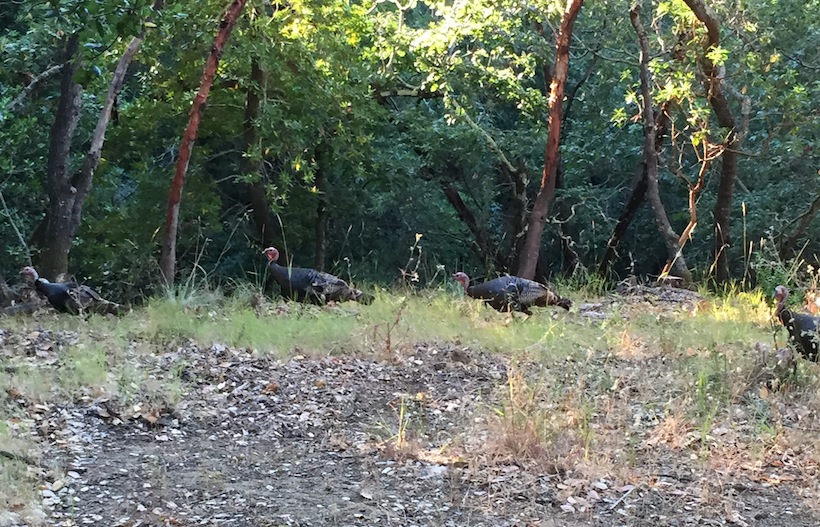
by Somya Devi | Nov 23, 2016 | Astrology, Holy Days
The Four Turkeys of Abundance and The Purusharthas
I saw these wild turkeys wandering through my “yard” (woods) earlier this year. Actually, I had begun seeing a lot of turkeys grazing up and down the hill fairly frequently. After seeing a group of fourteen together one day, I pulled out my animal wisdom medicine cards to check the significance of this totem. “Give-away,” it said. I was reminded that, of course, turkeys represent the spirit of giving and abundance. As we are reminded on American Thanksgiving, the turkey gives his own life to nourish others and provide abundance. He signifies the honor in those with the most sharing what they can with those who have less.
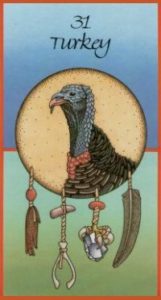
Credit, Sams & Carson goo.gl/QtRaQR
Something about these turkeys struck me this day, as the four of them let me wander closely behind. In thinking about abundance and the give-away idea, I was reminded of the Vedic concept of the purusharthas, or the four aims of life. This is a traditional yogic concept that outlines the general human pursuits we follow in order to live a balanced and fulfilling life of purpose. The four aims are: dharma (duty, truth), artha (material prosperity), kama (pleasure), and moksha (spiritual liberation). Each of these Sanskrit words and the concepts behind them may be investigated and discussed to great end, and there is much literature on the subject, but this will serve as a general introduction, based on my own experience and study.
What is interesting, as relative to Jyotish or Vedic astrology, is how these aims relate with the twelve houses in the individual natal chart. The houses represent twelve major areas of life through which everything in our conscious and subconscious lives can be understood. Of the twelve, three relate to dharma, three to artha, three to kama, and three to moksha. Each of the four pursuits are indicated once on the individual level, the interpersonal level, and the societal or universal level. It is said that to have a truly fulfilling life, we carry out karma (actions) towards all four aims of life.
Dharma
Dharma most generally indicates the idea of right living. It represents the idea of doing what is right, and living in truth. This concept is often loosely translated as duty or purpose, which has nuances in itself. We have many dharmas that are unique and individual, in the various roles we play in life. We may perform the dharma of being a mother in some of our actions, and that of a sister, a daughter, a partner, a friend, a teacher in others. My teacher always reminds us that we also have a para-dharma, a higher purpose, which is to know the divine. To live in harmony with the universe we do our best to know our dharma and fulfill it with love and joy. When we give ourselves through our unique purposes, we contribute to the functioning of the world as we know it.
The first house in one’s natal chart is the dharma house of the individual level. This represents all aspects of our general experience, our individuality, and our identity. We must discover and follow our personal truth here to find fulfillment. Dharma on the interpersonal level lies in the fifth house, which indicates our creativity. It shows what we manifest into the world from our love, and most specifically indicates children and romantic relationships. On the universal level, dharma plays out through the ninth house, the place of learning, teaching, and philosophy. Through the ninth house we can share our purpose at large through higher education and philosophical study.
Artha
Artha represents the idea of fulfilling a purpose in the material world. This includes the work that we do as professionals, as well as the material prosperity we gain from it. It can be a complex issue from a yogic perspective, but most simply suggests that work, income and financial security are valid pursuits (certainly for householders, as opposed to ascetics or renunciates). In my mind that certainly doesn’t validate luxurious excess, or the degree of wealth discrepancy that we see in the world today, but it means that it’s okay to make an offering and live comfortably. Following the turkey’s symbolism of giving, we should remember that part of gaining worldly success also lies in the giving.
In the Vedic astrology chart, the second house shows artha on the individual level. This house represents our money and possessions in general, as well as the family of origin and our immediate surroundings. The sixth house shows material pursuit on an interpersonal level. Here is where we need to do the hard work to support what we love and create, through things such as mundane tasks, chores, and standing up to those who challenge us. On the broader perspective we pursue artha through the tenth house, the place of career. The tenth house signifies what we put out into the world and the public arena.
Kama
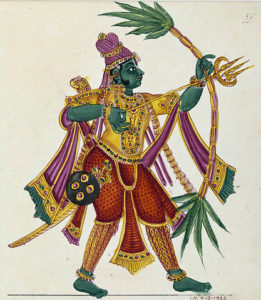
Kamadeva
Kama is actually the name of desire personified as a Hindu deity (aka Kamadeva, similar to Eros or Cupid). We are all divine sparks, but the universal design placed us divine beings here to live a human experience. Seeking fulfillment in desire, pleasure, and human love is certainly part of that. I would also argue that without this our yogic pursuits would be lacking, as observance of the mind’s desires seems fundamental to the perceived struggle against them. The desirous mind is part of what makes us human, and part of humanity’s aims as indicated by Vedic thought. Imagine that when we feel abundant in pleasure (not lustful), how much more love we are able to give to the world and those around us.
The third house in the astrological chart indicates our personal desires, our likes and dislikes, our hobbies, and our gut sense of “want.” The seventh house, the house of relationships, is where we pursue achieving pleasure while dancing with another person. This includes romantic relationships and sex, but it also represents the idea that to be happy around anyone–a friend, a business partner–a certain degree of compromise is necessary for both parties to find happiness. On a societal or universal level, we pursue desire through the themes of the eleventh house. Here we find our hopes and dreams, our community and friends, and our visions for and service to the world.
Moksha
Moksha is the idea of spiritual liberation, freedom, or the breaking of bondage. The fourth house is the dharma house of the individual level. It represents our innermost heart space (as well as personal spaces like our home and vehicles). It is through the fourth house and the heart that we find peace at the individual level. To find this, we must often break free from the bonds of attachment we have to our individual desires (3rd house), possessions (2nd house), and even to what has happened to us (our experience, 1st house).
The eighth house shows liberation on the interpersonal level, and can certainly be a difficult one. It represents sudden change, which can include death, divorce, and the breaking of relationships. This is also the house of transformation, however, when we begin to break free from the bonds of both our individual and interpersonal attachments. We can then begin to orient ourselves towards universal pursuits and consciousness, in the 9th-12th houses.
 The twelfth house, the house of loss, is the ultimate moksha house, where we pursue total liberation from our worldly life, karma, and the cycle of birth and death. It is here we can attain self-realization, higher knowledge, and divine communion. We actually experience the twelfth house through many moments in our lives, long before death, however. The twelfth house is the place of sleep, meditation, subconscious states, and the pre-natal state. It also represents other kinds of escapes from the daily experience, such as television, screens, intoxicants, retreats, hospital or jail stays, and foreign travel. When we have a strong twelfth house in the natal chart, it is of utmost importance to activate the higher potential of this house, which can lead us towards actual spiritual liberation.
The twelfth house, the house of loss, is the ultimate moksha house, where we pursue total liberation from our worldly life, karma, and the cycle of birth and death. It is here we can attain self-realization, higher knowledge, and divine communion. We actually experience the twelfth house through many moments in our lives, long before death, however. The twelfth house is the place of sleep, meditation, subconscious states, and the pre-natal state. It also represents other kinds of escapes from the daily experience, such as television, screens, intoxicants, retreats, hospital or jail stays, and foreign travel. When we have a strong twelfth house in the natal chart, it is of utmost importance to activate the higher potential of this house, which can lead us towards actual spiritual liberation.
When we achieve abundance and fulfillment here, we have one of the greatest gifts that we can then give in turn: wisdom. Should we be blessed to achieve true liberation, may we follow the exemplar of the great saints and sages. They stay on earth to teach and inspire, to love and serve, until every last one of us reaches the ultimate state of moksha. We are only as strong as our weakest link, and we are all connected by the same divine thread.
Each one of us wants to feel abundance in our lives. We will follow paths toward it through dharma, artha, kama, and moksha. When we count our blessings and offer gratitude, we will feel more abundant in certain areas, and perhaps less so in others. We can give thanks for what we do have, and do our best not to dwell on the areas where we are lacking. We should also keep faith and continue to pursue our dreams of fulfillment in all areas of life. Feeling completely “fulfilled” is a tall order before reaching said “ultimate liberation” mentioned above. Until then, we hopefully find inspiration to remain grateful, and to give away what we can to support others, as demonstrated by turkey medicine.
Did you like The Four Turkeys of Abundance & The Purusharthas? Please Like, Comment, and Share!
I intend to turn this into a longer piece, so if you have comments or other relevant articles, please feel free to post or send me a private message! Namaste.
Save
Save
Save
Save
Save
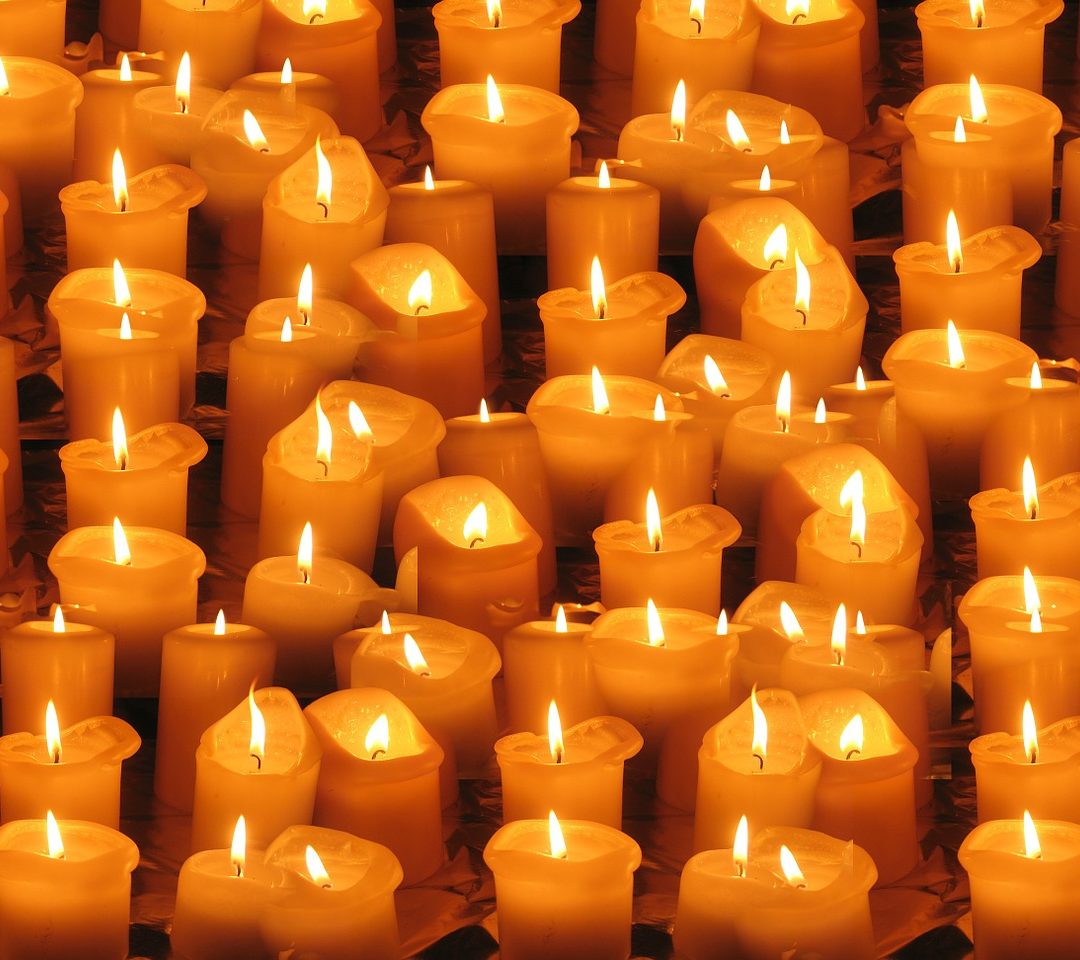
by Somya Devi | Oct 26, 2016 | Astrology, Conjunctions, Events, Holy Days
New Moon in Swati
Be careful not to become scattered this New Moon in Swati, on the dark night of Saturday, October 29th (*Times given for North America).
The Sun and Moon will coincide in this Vedic star-sign ruled by Vayu, the Lord of Wind, to kick off the next lunar cycle. The exact conjunction will be Sunday morning (at 10:38 a.m. PDT), with the darkest Moon phase on Saturday night. It will also coincide with a Venus-Saturn planetary war (exact conjunction), so we may feel a conflict between temporary pleasures and long-term goals (October 28-30). Thankfully, this dark Moon night also marks the time for celebrating Diwali (or Deepawali), the festival of light, wherein we celebrate prosperity and light prevailing over darkness! So it’s a great time to shine some light and turn our minds and hearts toward devotional practice.
Potential Depletion
There are a few factors creating the potential to feel scattered at this time, but there’s also a great opportunity to ground ourselves and steady our minds through focus and worship. In addition to Vayu’s influence, we in the Northern Hemisphere have been experiencing the cold winds increasing in the external atmosphere. As we go deeper into autumn, the vata dosha (comprised of air and ether elements) is increasing all around us. With the leaves falling and the weather changing, the process of decrease and sparsity in nature becomes evident. This results in an increase of vata energy, which can cause us to feel restless, anxious, spacey, dry, or depleted. It is extra important to do grounding and nourishing practices during this season, and to eat warm, moist, and heavier foods.***
What’s more, this lunar cycle begins with the Sun and Moon in Libra, where Sun is considered debilitated (not able to express strongly). Sun represents our vitality, energy, physical strength, and also our feeling of spiritual strength and connection with universal source. Not surprisingly, the time of year when he becomes “debilitated,” passing through Libra, is the same time we experience increased vata in the atmosphere and lessened immunity in our systems. It’s the time when we are most likely to catch a cold and begin to feel “spread thin” or “dried out.” While the Sun is in Libra, self-care is extra important. Take some time on this New Moon night to set intentions for how you will care for yourself during the coming cycle.
Another reason Sun is considered debilitated in Libra is because Libra is a sign that is very much about relationships. Sun represents our individual strength, so with Sun in Libra, we are more likely to put more of our attention on others, and on relationships, than towards our own physical health. We may be relating to our own personal power through our relationships during this time, rather than approaching it as individuals. While you are offering your love and compassion to others, don’t forget to nourish the divine within yourself as well, or you may end up feeling depleted. It is also easy to become drained when we try too hard to balance everything, another temptation of Sun in Libra.
Swati Symbolism
Thankfully, the divine universe always seems to offer just the right opportunities for solving the same challenges it presents. We just need to be willing to do the work on ourselves. This new Moon is in the part of Libra known as Swati, “the independent one,” which reminds us of our independent nature, despite the strong emphasis we may be putting on relationships at the moment. This star-sign helps remind us to look for our own inherent power, shining forth like the inner Sun.
Vayu, the wind god, is the ruler of Swati, and can bring in a restless and scattered energy to this star. He is also the father of Lord Hanuman, who is known as the greatest devotee. One lesson we learn from Hanuman is that through loving devotion, even a restless monkey mind can be tamed. He had endless devotion for Lord Rama, which gave him invincible powers to accomplish seemingly impossible tasks. Though we all have restless monkey minds at times, if we direct our attention toward love, light, or our chosen deity, we will be able to steady the mind and find immense strength within.
Practice Ideas
Some ways to still your mind through one-pointed focus include:
- Mantra recitation
- Asana practice
- Scriptural study
- Meditation on candlelight, a statue, or an image
Though a young sprout blowing in the wind (a symbol of Swati) may seem perilous, it is actually growing stronger so as to withstand the intense force of the outer circumstances. Eventually, it could grow into a tall redwood, cutting through the wind like a sword (another symbol of Swati). Swati is also related to the symbolism of a priest, which shows us the possibility for reclaiming both power and balance through devotional or spiritual practice.
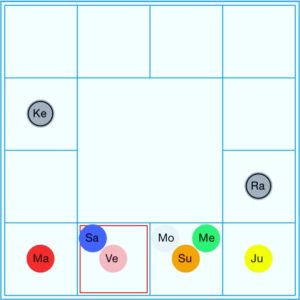 Kala Saarpa Yoga
Kala Saarpa Yoga
We may feel extra intensity seemingly out of nowhere, for the next two weeks during which the planets align in a Kala Saarpa yoga. This means that the seven major planets are all in between Rahu and Ketu, the two lunar nodes. This heavy alignment can bring up a lot of shadow work, so it is a good time to engage your toolbox for self-development. With Ketu in Shatabisha, the sign of the “hundred medicines,” alternative medicines and healing modalities can be useful towards this end.
Diwali
With all this energy in the atmosphere, enjoy the opportunity for worship offered by the advent of Diwali! This Hindu festival of light is celebrated for 6 or 7 days, with the main Diwali festival on the night of October 29th. Diwali, or Deepawali, comes from Deepa + avali, “a row of lights.”
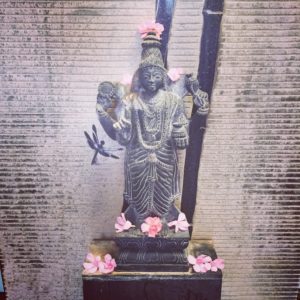 Thursday (North America) is both Dhanvantari Tryodashi (or Dhanvantari Jayanti, the birth of Lord Dhanvantari), and Dhanteras (a part of the Diwali festival). It is the thirteenth day of the waning Moon in the Vedic month of Ashwayuja. Lord Dhanvantari is known as the “father of Ayurveda” and the “physician of the Gods.” (Ayurveda is the system of natural medicine from India that is a sister science to yoga and Jyotish.) If you practice any healing tradition, especially Ayurveda, this is a good day to give thanks and call in auspicious blessings to your healing path or practice.
Thursday (North America) is both Dhanvantari Tryodashi (or Dhanvantari Jayanti, the birth of Lord Dhanvantari), and Dhanteras (a part of the Diwali festival). It is the thirteenth day of the waning Moon in the Vedic month of Ashwayuja. Lord Dhanvantari is known as the “father of Ayurveda” and the “physician of the Gods.” (Ayurveda is the system of natural medicine from India that is a sister science to yoga and Jyotish.) If you practice any healing tradition, especially Ayurveda, this is a good day to give thanks and call in auspicious blessings to your healing path or practice.
Thursday also marks Dhanteras, the first day of the Diwali festival (the Hindu festival of light). It commemorates the day that Lakshmi emerged from the milk ocean. In India, it is customary to purchase metals on this day — anything from jewelry to new statues to kitchenware (excluding iron), as a part of celebrating Lakshmi and calling in more prosperity. The metals can then be offered to your altar and will absorb and amplify the benefits of worship performed over the few days of Diwali.
It is customary to perform a puja to Lakshmi on the third night of Diwali (this Saturday in North America). Goddess Lakshmi represents wealth and prosperity (spiritual and material), as well as devotion, love, beauty, and happiness. Celebrating her on Diwali is a way to call these qualities into our lives.
It is also traditional to light candles throughout Diwali, to remind us of the divine light within. Diwali is also related to the story from the Ramayana about Lord Rama’s return from exile after fourteen years. It thus symbolizes light and goodness emerging from times of darkness. Lord Rama represents dharma, or doing our duty, as well as devotion, compassion, courage, and righteous leadership. Diwali celebrations often commemorate his and Sita’s return to the kingdom of Ayodhya after their exile.
On Saturday night as we prepare to enter the next lunar cycle, light a candle! Turn your mind toward the divine so as to focus and ground, through the practices that work best for you. Set some intentions as to how you will practice self-care during this cycle (and be sure to find me on Facebook for a live chat with tips for how to do this!).
Ram Ram, Namaste
***Be sure to Follow me on Facebook so you can tune in for my upcoming Facebook Live talks about the New Moon AND Ayurvedic tips for how to stay balanced during the high vata season!
**Limited requests for personal Vedic Astrology readings before the New Year are now available Here.
Save
Save
Save
Save

by Somya Devi | Sep 29, 2016 | Astrology, Conjunctions, Events, Holy Days, Planets Changing Signs
The New Moon in Virgo on September 30th offers us another chance to be still, go inward, let go, and step forth anew into the Virgo lunar cycle the next day. Saturday opens to the door to Navaratri, an important Hindu festival in which the Goddess is worshiped for nine nights and ten days.
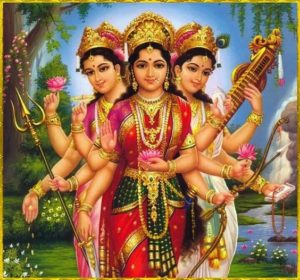
Don’t miss the full details about Navaratri, the Goddess’s forms, and how to celebrate, Here!
The exact New Moon is at5:12 p.m. (PDT) on Friday, September 30, when Sun and Moon converge at 14° of sidereal Virgo, in the Vedic nakshatra called Hasta (“the hand”). This creative star-sign brings an energy of “handiness,” conducive for arts, crafts, music, as well as intellectual craftiness and skillfulness.
Now that we have passed the equinox and begun to descend into the darker months (in the northern hemisphere)*, this is a great time to return to things like arts and crafts as we begin spending more time at home and cultivating our inward practices. Winter is the “yin” part of the year, so if we are aligned with nature, we sense that it is time to slow down and turn inward. The yin season can offer a lot more opportunity for personal practices than the “yang” part of the year, when our long days are filled with more outward activity and movement.
This Virgo Moon cycle is also a great time to get organized and create new routines in our lives. Consider a “fall cleaning,” getting rid of the old clutter that has accumulated over the busy summer months. This will create more space in your sanctuary that you will want for your self-care, home yoga practice, crafting, meditation, or whatever it is that you do to rest and recharge. Because Jupiter is also joining this New Moon in Virgo, you’ll feel extra grace coming at you this month, which will help you to get in alignment with your principles and ideals. It’s a good opportunity to reconnect with higher teachings and teachers, as well as to solidify some healthy habits in your life.
Between the New Moon and the 13th we’ll be experiencing a Kala Sarpa yoga again, when all of the planets fall on one side of the nodal (Rahu-Ketu) axis. This can add some intensity to our experiences … all the better reason to channel that energy into spiritual practice, worship, and surrender by celebrating Navaratri!
On October 10th Jupiter and Mercury will come into exact alignment in Virgo, which could cause us to stress out over the details a bit. Remember that practice and progress can be better goals than perfection. If your ideals seem out of reach or unpractical, give it a few days and be easy on yourself.
On October 13th, Venus will join Saturn in Scorpio, putting on some pressure in the area of relationships. It might be time to make a big commitment, or to put in the hard work needed to take things to a deeper level. These two will be together in Scorpio for almost a month, so it will be a time to really look at our fears around relationships, the effort we need to put into them, and how they contribute to our personal growth and transformation. Scorpio helps to teach us the lesson of surrender, as we face our own vulnerabilities and learn to recognize what is beyond our control.
 After the Full Moon on October 15th, the Sun will transition from Virgo into Libra on the 16th. With Sun in Libra, his sign of debilitation, self-care becomes extra important. We might feel less energy than usual or be more susceptible to seasonal illness. We can also become easily depleted, especially with all the work we are doing around relationships. Be sure to honor yourself with some self-nourishment–grounding and nourishing food, warm baths, hot tea, and time to rest.
After the Full Moon on October 15th, the Sun will transition from Virgo into Libra on the 16th. With Sun in Libra, his sign of debilitation, self-care becomes extra important. We might feel less energy than usual or be more susceptible to seasonal illness. We can also become easily depleted, especially with all the work we are doing around relationships. Be sure to honor yourself with some self-nourishment–grounding and nourishing food, warm baths, hot tea, and time to rest.
*In the southern hemisphere, the September equinox opened the door to the ascending cycle, where you may find yourself coming out of the winter shell and beginning to go out more, start exercising again, and increase your activity. Nevertheless, you can channel the energy of Virgo into creating healthy habits that will help you to stay balanced through the summer.
Did you like New Moon in Virgo? Please Like, Comment, and Share!
Save

by Somya Devi | Sep 26, 2016 | Astrology, Events, Holy Days
Maha Navaratri 2016 will be from October 1st-10th, the first ten days of this new lunar cycle. In this important Hindu holiday, we celebrate the Goddess through “the great nine nights.” Goddess, Devi, Shakti, Durga, Divine Mother, the many names and forms all represent the dynamic and fluid feminine power that enlivens all of existence.
She is the creatrix, the warrioress, the nurturer, the purifyer, the protector. While she’s in the innocent and fertile maiden so is she the wise and learned crone. Both the nurturing mother, and the one who gives “tough love.” The impassioned lover, the devoted bhakta, the disciplined yogini. We see Goddess appear through us in innumerable manifestations. Through her many forms she teaches us and offers us countless blessings–love, compassion, courage, learning, discipline, surrender, success, enlightenment, and bliss. This festival is a time for celebrating the supreme feminine power in all her glory, and the many blessings she bestows upon us.
As with most Hindu celebrations, this festival correlates with the lunar calendar, and thus begins on the first day of the waxing Moon after the New Moon of September 30th. The celebration is through the “nine nights” of October 1-9, 2016, and into the tenth morning known as Vijayadashami, “the day of victory,” on October 10th. Worship during Navaratri is most generally dedicated to Goddess in the form of Durga, the demon-slayer, but there is much nuance and variation to practice and forms of celebration throughout India. Above all, Navaratri is a community celebration of the Divine Mother, and the love, abundance and protection she gives.
There are many Navaratri celebrations throughout the year, but the fall-time Navaratri is the most widely celebrated, and is thus called Maha Navaratri – “the great nine nights”. It correlates with the time of the harvest, a time to give thanks for the abundance of the year’s work. Grains and crops are often offered to Devi as part of the celebrations. Ritualistic worship (puja) typically occurs in homes and temples throughout the nine nights and into the tenth morning of celebration.
The Many Forms of Goddess
Durga-Lakshmi-Sarasvati
In Kerala and other places in India, the first three nights of worship are dedicated to Durga (the invincible), the next three to Lakshmi (Goddess of prosperity), and the final three to Sarasvati (Goddess of learning). Durga helps us to destroy and remove the negative tendencies in our minds and hearts, freeing us from the obstructions to our spiritual and material pursuits. Lakshmi helps us to cultivate positive qualities like compassion and devotion, and leads us towards both spiritual and material prosperity. Sarasvati assists us in attaining knowledge and wisdom, through the illumination of our consciousness. She aids in awakening sattva, the quality of purity, and the flow of prana, the vital breath. After removing inner and outer obstacles and cultivating prosperity through virtuous qualities, our devotion, service, and practice help us to attain a state of peace, bliss, and oneness.
Sarasvati-Lakshmi-Kali/Durga
In the Kali Kula (Kali school of worship) in northeastern India, Sarasvati is worshiped on the first three nights, followed by Lakshmi and then Kali/Durga on the last three. Sarasvati, Lakshmi, and Kali/Durga (Kali emerged from Durga) are also known as the consorts of Brahma, Vishnu, and Shiva. The Goddesses, therefore, provide the shakti to the cosmic processes of creation, preservation, and death/transformation, similar to their male counterparts. Consequently, worship in this manner is dedicated to the cycles of life and Mother nature, through birth, then sustenance, then death. Death is not a complete stop, but allows for the regeneration of energy into a new cycle once again.
9 Forms of Goddess
Throughout India, the nine nights of Navaratri are often dedicated to 9 different incarnations of Durga, allowing the worship of many different aspects of Shakti in a gradual evolution. You can read the stories and significance of these 9 goddesses here, or a more a brief introduction, here:
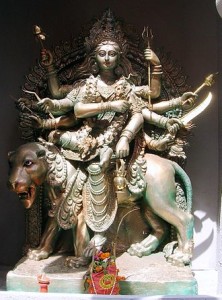 1. Shailputri
1. Shailputri
“Daughter of the mountain”; creative energy, muladhara (root chakra), awakening; Awaken your connection with Goddess today or initiate a new venture, calling on Shailputri for new beginnings.
2. Brahmacharini
The ascetic; tapas, discipline, devotion, strength, wisdom, creative abundance; Good day for fasting and meditation, connection with svadhistana (sacral chakra).
3. Chandraghanta
Warrioress; protection, courage, grace, manipura (solar plexus); Destroy your internal obstacles by offering them to Chandraghanta.
4. Kushmanda
Creatrix of the “cosmic egg”; strength, health, happiness, success, relationships; Connect with the vital Sun energy and the anahata (heart chakra) today.
5. Skandamata
“Mother of Skanda/Kartikeya”; motherly love, nourishment, protection, purity; Call on divine truth through the vishuddha (throat chakra), invoking Skandamata to lead you towards victory.
6. Katyayani
Warrioress who destroyed Mahishasura (the buffalo demon); victory, devotion, strength, removing obstacles; Meditate on these qualities of Goddess through the ajna chakra (third-eye) today.
7. Kalaratri
“Dark/black night,” representing a fierce form of Durga/Kali; darkness, death, surrender, dissolution of pain; Connecting with the sahasrara (crown chakra), remember that Divine Mother offers love, compassion, and many blessings even in hard times. Even in the midst of apparent darkness, and helps us to go beyond the boundaries of the material body-mind and connect with spirit.
8. Mahagauri
“Great white goddess”; detachment, purification, renewal, protection, virtue; Through detachment and devotion, we emerge purified, shining and radiant after surrendering in the dark night. Rejuvenative herbs and foods are good today.
9. Siddhidatri
Goddess of “siddhis”; magical, spiritual or mystic powers and blessings, fulfillment of desires, devotion, divine union; Invite Goddess to reveal her presence to you everywhere and in every moment.
Personal Practice Ideas for Navaratri
If possible, it is great to reduce our workload and gather with community at local temples or places of worship. We can also create a little time and space at home and conduct some personal practices to celebrate Goddess energy. Here are some ideas to do at home or with a group throughout the nine nights of Navaratri:
Altar
Create a sacred space, a Durga altar, or a Goddess altar. Even if you already have one, you can refresh it in some way or rearrange it specifically for Navaratri. Include images or statues of the Goddess(es) you have a relationship with. This could be according to one of the groups of forms above.
Invocation
Even if you don’t have much time, dedicate at least a few minutes each day to connecting with the Divine Mother in front of your altar.
Journal
Write in your journal about what qualities of Goddess you perceive and connect with. What aspects would you like to strengthen or to cultivate more deeply? Write any and all prayers and offer them to the form of Goddess that appeals to you.
Light
Offer light to illuminate Goddess’s power, helping her to shine more brightly into the world and your life. You can light a candle by the altar and keep it burning when you’re at home. You can even keep an electronic tealight on symbolically when you are away.
Flowers/Grains
Offer flowers or grains (even a small dish of dried rice) to celebrate Devi in the form of mother nature, fertility, the abundance of the harvest, and the cycle of life.
Offerings
Offer incense, bells, water, or food if you feel called, by placing it on the altar, or mentally offering it to Goddess throughout the day. You can also offer something symbolic of your own work or practice, whatever you have been cultivating for harvest through the year. In offering this you surrender the fruits of your efforts to the Divine Mother.
Fasting
Some people choose to fast in some variation, if this is something you have practiced before. This might include fasting during the day, fasting with only milk or fruit, or abstaining from alcohol and non-vegetarian foods during Navaratri.
Chanting
Chanting the Devi Mahatmyam, a verse to the Goddess, is a common practice during the nine-night festival. You can also chant another Goddess mantra or songs that are special to you and your relationship with Devi.
JAI MA DURGA!
Personal Vedic Astrology chart readings and forecasts are available Here.
Did you like Maha Navaratri 2016? Please Like, Comment and Share!
Save
Save
Save



 On Shivaratri, it is a common practice to stay up the whole night in meditation, fasting and praying. This commemorates the sacrifice made by Lord Shiva when he kept the poison that arose from the milk ocean in his throat in order to protect the entire creation. In this story, his wife Parvati held his throat to keep him from consuming the poison, and thus this holiday also commemorates the union of masculine and feminine forces, Shakti and Shiva, yin and yang. In many places this is represented by a celebration of Shiva and Parvati’s wedding, and one may see large statues of the two paraded about town and worshiped.
On Shivaratri, it is a common practice to stay up the whole night in meditation, fasting and praying. This commemorates the sacrifice made by Lord Shiva when he kept the poison that arose from the milk ocean in his throat in order to protect the entire creation. In this story, his wife Parvati held his throat to keep him from consuming the poison, and thus this holiday also commemorates the union of masculine and feminine forces, Shakti and Shiva, yin and yang. In many places this is represented by a celebration of Shiva and Parvati’s wedding, and one may see large statues of the two paraded about town and worshiped.













